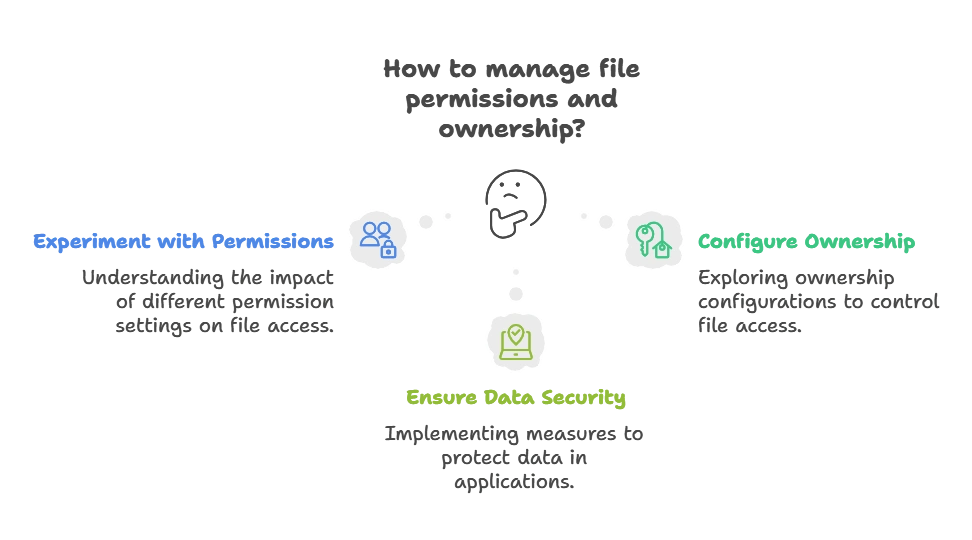File Permission and Ownership in Go
Understanding file permissions and ownership is crucial for managing security and access control in file systems. In this chapter, we'll delve into the concepts of file permissions and ownership in Go, covering everything from basics to advanced topics
Introduction to File Permissions and Ownership
File permissions determine who can read, write, and execute files on a system, while ownership specifies the user and group associated with a file. These concepts are fundamental for ensuring data security and controlling access to sensitive information.
In this section, we’ll cover the basics of file permissions, including how to view and modify them in Go.
Viewing File Permissions
You can view file permissions using the Stat() method from the os package in Go.
We use os.Stat() to retrieve information about the file "example.txt".
The Mode() method returns the file mode, and Perm() extracts the permission bits from it.
We print the file permissions to the console.
Modifying File Permissions
You can modify file permissions using the Chmod() method from the os package in Go.
package main
import (
"fmt"
"os"
)
func main() {
err := os.Chmod("example.txt", 0644)
if err != nil {
fmt.Println("Error:", err)
return
}
fmt.Println("File permissions modified successfully")
}
- We use
os.Chmod()to change the permissions of the file “example.txt” to0644(readable and writable by the owner, readable by others). - If there’s an error during the operation, we handle it and print an error message.
- We print a success message indicating that the file permissions have been modified successfully
Advanced File Permission and Ownership Management
In this section, we’ll explore advanced techniques for managing file permissions and ownership in Go.
Changing File Ownership
You can change file ownership using the Chown() method from the os package in Go.
package main
import (
"fmt"
"os"
"syscall"
)
func main() {
err := os.Chown("example.txt", os.Getuid(), os.Getgid())
if err != nil {
fmt.Println("Error:", err)
return
}
fmt.Println("File ownership changed successfully")
}
- We use
os.Chown()to change the ownership of the file “example.txt” to the current user and group. - If there’s an error during the operation, we handle it and print an error message.
- We print a success message indicating that the file ownership has been changed successfully.
Access Control Lists (ACLs)
Access Control Lists (ACLs) provide a more granular level of control over file permissions by allowing users to define access permissions for specific users or groups beyond the traditional owner, group, and others categories.
Understanding ACLs
ACLs extend the basic file permissions model by enabling users to specify permissions for individual users or groups on a per-file basis.
package main
import (
"fmt"
"os"
"golang.org/x/sys/unix"
)
func main() {
err := unix.Setxattr("example.txt", "system.posix_acl_access", []byte("user::rwx,group::r--,other::---"), 0)
if err != nil {
fmt.Println("Error:", err)
return
}
fmt.Println("ACLs set successfully")
}
- We use the
Setxattr()function from thegolang.org/x/sys/unixpackage to set ACLs for the file “example.txt”. - The ACL string specifies read, write, and execute permissions for the owner, read-only permissions for the group, and no permissions for others.
Retrieving ACLs
You can retrieve ACLs for a file using the Getxattr() function.
package main
import (
"fmt"
"os"
"golang.org/x/sys/unix"
)
func main() {
data := make([]byte, 1024)
size, err := unix.Getxattr("example.txt", "system.posix_acl_access", data)
if err != nil {
fmt.Println("Error:", err)
return
}
fmt.Println("ACLs:", string(data[:size]))
}
- We use the
Getxattr()function to retrieve ACLs for the file “example.txt”. - The ACLs are stored in the
databuffer, and thesizevariable indicates the length of the ACL string. - We print the retrieved ACLs to the console.

Understanding file permissions and ownership is essential for managing security and access control in file systems. By mastering these concepts and exploring advanced techniques in Go, you can effectively control access to files and ensure data security in your applications. Experiment with different permission settings and ownership configurations to understand their impact on file access and security. Happy coding !❤️
